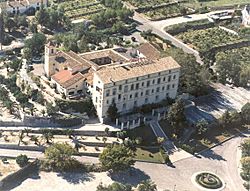Monastery of Aguas Vivas facts for kids
| Monasteri d'Aigües Vives | |
 |
|
| Monastery information | |
|---|---|
| Full name | Royal Monastery of Santa María de Aguas Vivas |
| Established | 13th century |
| Diocese | Valencia |
| Site | |
| Location | Carcaixent (Valencia) |
| Coordinates | 39°5′21.35″N 0°21′16.67″W / 39.0892639°N 0.3546306°W |
| Visible remains | Restored |
| Public access | Yes |
The Monastery of Santa María de Aguas Vivas is a very old religious building. It is located in the town of Carcaixent in Spain. This monastery was first built way back in the 13th century.
History of the Monastery
The building you see today was mostly built much later. This happened during the 16th and 17th centuries. It has a mix of old Gothic and fancy Baroque styles. The northern part of the building was finished even later, in the 18th century.
This monastery used to belong to a group of monks called the Augustinians. They were the guardians of a special image of the Virgin of Aguas Vivas. She is the patron saint of Carcaixent.
In the mid-1800s, something big happened. The government took over many church properties. This event is known as the Ecclesiastical Confiscations of Mendizábal. Because of this, the monks had to leave the monastery. It then became a country home for a rich family, the barons of Casanova.
Later, in 1977, a photographer and businessman named Antonio Vidal Bellver bought the monastery. He fixed it up to turn it into a hotel. Today, a well-known businessman from Gandia owns the monastery.
What the Monastery Looks Like
The main shape of the monastery was created during the 16th and 17th centuries. A Valencian architect named Francisco Colom helped make it bigger in 1597. He especially worked on the cloister.
More building work happened in 1633 and 1695. During these times, a new church was planned and built. It included an altar, a special room for priests' robes (sacristy), and a bell tower.
The monastery is built around a central courtyard called a cloister. The church is on the south side. Farm buildings are on the north. A large, tall building with five floors faces the road to Alzira and Tavernes de la Valldigna on the east.
On the west side, you'll find the bell tower and the church. There's also the entrance to the cloister and more farm buildings. The cloister itself is not very big, but it has beautiful carvings and colorful paintings. In the middle of the cloister, there's a water well.
To the left of the cloister is the dining hall, and next to it is the kitchen. The bell tower is tall and has a unique sundial on it. Above that, there's a section with bells and arched windows. The roof is made of traditional Arabic tiles and has a metal weather vane on top.
The front of the church has a pointed roof. The entrance door is rounded and has a ceramic picture of Nuestra Señora de Aguas Vivas. The cloister's front entrance has a fancy arch with a family crest. It is flanked by two rectangular windows. On the top floor, there are two large windows and a balcony.
The church inside has one main aisle. Besides the main altar, there are six smaller chapels on the sides. The area around the main altar has two doors. One leads to the cloister, and the other used to lead to the old sacristy, which is now a wine cellar.
The church also has a high choir area with a rounded railing. The choir stalls, where people sit, are from two different times: the 15th century (Gothic style) and a later period called Plateresque. The church's ceiling is shaped like a barrel.
See also
 In Spanish: Convento de Aguas Vivas para niños
In Spanish: Convento de Aguas Vivas para niños


